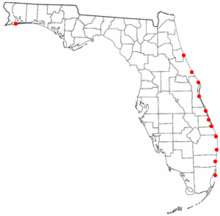
St. Lucie County is a county located in the southeastern portion of the U.S. state of Florida. As of the 2020 census, the population was 329,226. The county's seat is Fort Pierce. St. Lucie County is included in the Port St. Lucie, FL Metropolitan Statistical Area.

Key Biscayne is an island located in Miami-Dade County, Florida, located between the Atlantic Ocean and Biscayne Bay. It is the southernmost of the barrier islands along the Atlantic coast of Florida, and lies south of Miami Beach and southeast of Miami. The key is connected to Miami via the Rickenbacker Causeway, originally built in 1947.

The Hereford Inlet Light is a historic lighthouse located in North Wildwood in Cape May County, New Jersey, United States, situated on the southwestern shore of Hereford Inlet at the north end of Five Mile Beach. Its construction was completed and it became operational in 1874.
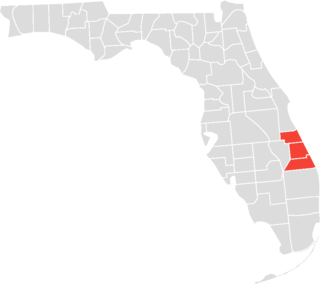
The Treasure Coast is a region in the southeast of the U.S. state of Florida. It borders the Atlantic Ocean and comprises Indian River, Martin, and St. Lucie Counties. The region, whose name refers to the Spanish Treasure Fleet that was lost in a 1715 hurricane, evidently emerged from residents' desire to distinguish themselves from the Gold Coast to the south.

The United States Life-Saving Service was a United States government agency that grew out of private and local humanitarian efforts to save the lives of shipwrecked mariners and passengers. It began in 1848 and ultimately merged with the Revenue Cutter Service to form the United States Coast Guard in 1915.
The barefoot mailman is an iconic Florida symbol. It refers to the carriers on the first U.S. Mail route (1885–1892) between Palm Beach and the settlements around Lake Worth on the north, and Miami, Coconut Grove, and Lemon City to the south. The mailmen had to walk and travel by boat because there was no road connecting the 68-mile route from Palm Beach to Miami. Approximately 28 miles of the one way trip was by rowing different boats, and the rest by walking along the firmer sand along the beach. The route was a Star Route, with the carriers contracting with the Post Office. The route was originally called the "barefoot route" and the carriers were called "beach walkists" or "beach walkers". It was not until around 1940 that the term "barefoot mailman" came into use.

The St. Lucie Inlet, Florida is located between Hutchinson Island and Jupiter Island in Martin County, Florida, at coordinates 27°09′58″N80°09′24″W. The St. Lucie Inlet is one of six inlets into the Indian River Lagoon.

The Cape Florida Light is a lighthouse on Cape Florida at the south end of Key Biscayne in Miami-Dade County, Florida. Constructed in 1825, it guided mariners off the Florida Reef, which starts near Key Biscayne and extends southward a few miles offshore of the Florida Keys. It was operated by staff, with interruptions, until 1878, when it was replaced by the Fowey Rocks lighthouse. The lighthouse was put back into use in 1978 by the U.S. Coast Guard to mark the Florida Channel, the deepest natural channel into Biscayne Bay. They decommissioned it in 1990.
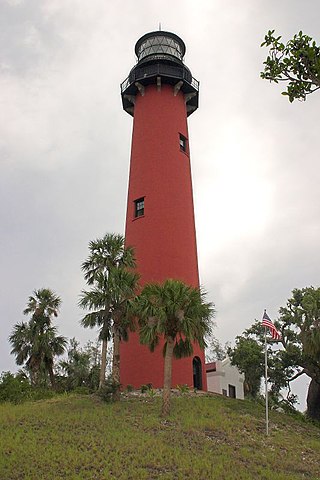
The Jupiter Inlet Light is located in Jupiter, Florida, on the north side of the Jupiter Inlet. The site for the lighthouse was chosen in 1853. It is located between Cape Canaveral Light and Hillsboro Inlet Light. The lighthouse was designed by then Lieutenant George G. Meade of the Bureau of Topographical Engineers. Meade's design was subsequently modified by Lieutenant William Raynolds. The Jupiter Inlet silted shut in 1854, forcing all building supplies to be shipped in light boats down the Indian River. Work was interrupted from 1856 to 1858 by the Third Seminole War. The lighthouse was completed under the supervision of Captain Edward A. Yorke in 1860 at a cost of more than $60,000.
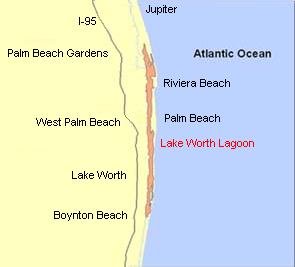
The Lake Worth Lagoon is a lagoon located in Palm Beach County, Florida. It runs parallel to the coast, and is separated from the Atlantic Ocean by barrier beaches, including Palm Beach Island. The lagoon is connected to the Atlantic Ocean by two permanent, man-made inlets.

The Amelia Island Light is the oldest existing lighthouse in the state of Florida in the United States. It is located near the northern end of Amelia Island in the northeastern part of the state. Its light marks St. Marys Entrance, the inlet leading to St. Marys River, the Cumberland Sound and the harbor of Fernandina Beach, Florida along the Amelia River. The white light flashes every ten seconds which turns red from 344° to 360° when covering the shoal water in the vicinity of Nassau Sound.

The Palm Beach Inlet, also known as the Lake Worth Inlet is an artificial cut through a barrier island connecting the northern part of the Lake Worth Lagoon in Palm Beach County, Florida with the Atlantic Ocean. It is bordered by the town of Palm Beach on the south, and by the town of Palm Beach Shores to the north. The inlet is also the entrance channel for the Port of Palm Beach. Its coordinates are 26°46′20″N80°02′14″W.

The Ponce de Leon Inlet Light is a lighthouse and museum located at Ponce de León Inlet in Central Florida. At 175 feet (53 m) in height, it is the tallest lighthouse in the state and one of the tallest in the United States. It is located between St. Augustine Light and Cape Canaveral Light. Restored by the Ponce de Leon Inlet Lighthouse Preservation Association, the lighthouse became a National Historic Landmark in 1998.

The House of Refuge at Gilbert's Bar, also known as Gilbert's Bar House of Refuge, the House of Refuge Museum, or simply the House of Refuge, is a historic building located at 301 S.E. MacArthur Boulevard, on Hutchinson Island east of Stuart, Florida. It is the oldest surviving building in Martin County.
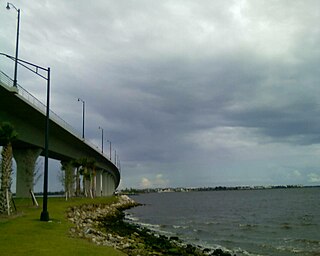
North Hutchinson Island is a coastal barrier island in Indian River and St. Lucie counties on the east coast of Florida in the United States. The island is adjacent to the Atlantic Ocean and is separated from the mainland on the west by the Indian River Lagoon. The portion of the island in Indian River County is known as Orchid Island.

Pea Island Life-Saving Station was a life-saving station on Pea Island, on the Outer Banks of North Carolina. It was the first life-saving station in the country to have an all-black crew, and it was the first in the nation to have a black man, Richard Etheridge, as commanding officer. On August 3, 2012, the second of the Coast Guard's 154-foot Sentinel-Class Cutters, USCGC Richard Etheridge (WPC-1102), was commissioned in his honor.

The Indian River Life-Saving Station was established at Rehoboth Beach, Delaware in 1876 to rescue mariners shipwrecked along the Delaware coast, as part of the United States Life-Saving Service. It was designed in 1874 as a 1+1⁄2-story board-and-batten frame structure with decorative brackets supporting overhanging eaves in a version of the Queen Anne style. It sheltered a surfboat which could be quickly rolled out through double doors facing the beach and down a ramp to the water. The main station house remains of what was once a complex that included a barn, stable, meat house, feed house and privy. An auxiliary boathouse stood about a mile to the south. The original plans for the station survive.
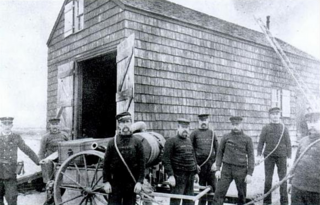
Coast Guard Station Toms River is a former United States Coast Guard station in Seaside Park, New Jersey at the mouth of the Toms River. The area was manned in 1856 with Samuel Chadwick as the first lifeguard. The first boathouse was constructed in 1872 by the New Jersey Life Saving Service as the Toms River Life Saving Station. Station Toms River was United States Life-Saving Service Station #13 and Coast Guard's Station #109 in the 5th District.

Charles William "Charlie" Pierce was one of South Florida's most important pioneer citizens. Arriving in 1872, Pierce was a community leader in banking, seamanship, the postal service, and author of the sentinel book on early South Florida life.

This is a list of United States Coast Guard historical and heritage sites that are open to the public. This list includes National Historic Landmarks (NHL), the National Register of Historic Places (NRHP), cutters, museums, monuments, memorials and more. It includes only NHL Lighthouses. There are many more resources dedicated to lighthouses, this list attempts to collect everything else in one list. The United States Lighthouse Society, Lighthouse Friends and the many Wikipedia pages dedicated lighthouses are a few of the many excellent resources for those interested in lighthouses. This list captures the most important historical features, that is the NHL and the often overlooked U.S. Coast Guard sites.

